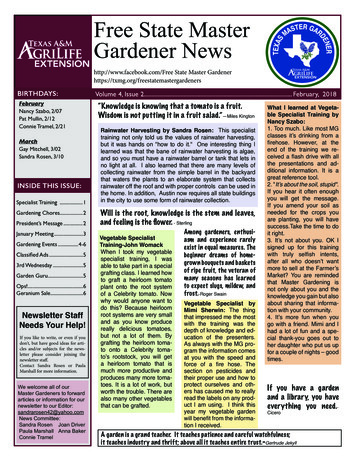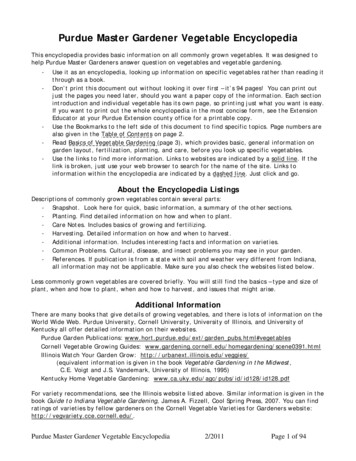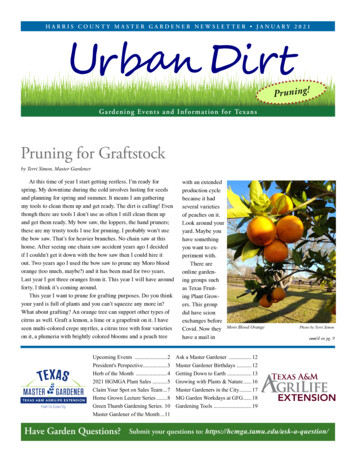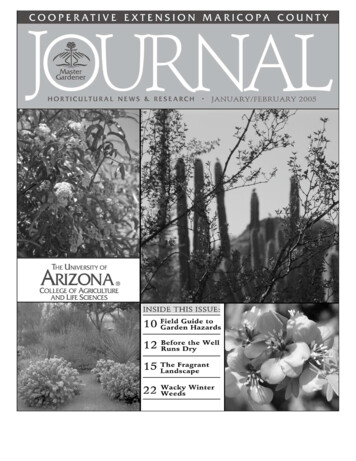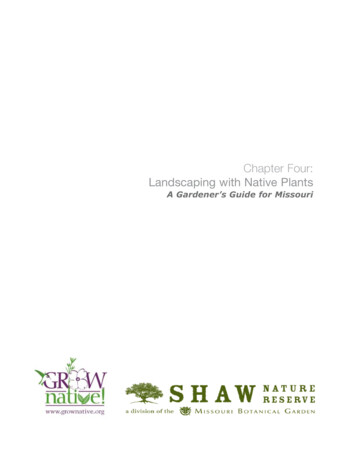
Transcription
Chapter Four:Landscaping with Native PlantsA Gardener’s Guide for Missouri
Landscaping with Native PlantsA Gardener’s Guide for MissouriIntroductionGardening with native plants isbecoming the norm rather than theexception in Missouri. The benefitsof native landscaping are fueling agardening movement that says “no”to pesticides and fertilizers and “yes”to biodiversity and creating moresustainable landscapes. Novice andprofessional gardeners are turning tonative landscaping to reduce maintenance and promote plant and wildlifeconservation. This manual will showyou how to use native plants to create and maintain diverse and beautiful spaces. It describes new ways togarden lightly on the earth.Chapter Four: Landscaping withNative Plants provides tools gardeners need to create and maintain successful native plant gardens. Theinformation included here providespractical tips and details to ensuresuccessful low-maintenance landscapes. The previous three chapters include Reconstructing TallgrassPrairies, Rain Gardening, andControl and Identification of InvasiveSpecies.History of NativeLandscapingAn early proponent of native landscaping was Wilhelm Miller who wasappointed head of the University ofIllinois extension program in 1912. Hepublished a number of papers on theNative landscapes in the WhitmireWildflower Garden, Shaw Nature Reserve.use of native plants in residential garden design, farming, parks, roadsides,and prairie restoration. Miller called hiswork “The Prairie Spirit in LandscapeDesign”.One of the earliest practitioners ofMiller’s ideas was Ossian C. Simonds,a landscape architect who worked inthe Chicago region. In a lecture presented in 1922, Simonds said, “NatureIntroduction
3teaches what to plant. By going tothe neighboring woods and seeingthe trees and plants and shrubs theycontain, one can tell pretty accurately what plants will do well in anygiven locality.” Nearly 100 years agoSimonds, Miller, and others understoodthat native plants are a good choice foruse in landscaping and they were right.Today native plants are used in residential and commercial landscaping,highway projects, habitat restoration,storm-water management, for parksand corporate office buildings.Why Use Missouri NativePlants?Local Ecotype Native Plantsprairies, wetlands, river-bottom forests, glades and upland savannas.They have evolved with the extremesof our climate, a wide array of pathogens and a variety of soil and moisture types, creating a palette ofdurable and showy Missouri nativeplants that are the focus of landscapegardening. Plants such as yellow wildindigo (Baptisia sphaerocarpa), nativeto the tallgrass prairie, and whitetinged oak sedge (Carex albicans),which grows in dry woodlands, areeasy-to-grow beauties being showcased in botanical garden displays,Metro St. Louis Sewer District raingardens, and homeowners’ flowerbeds. Gardeners who use Missourinative plants have more success thanthose who use plants from otherregions of the United States.Missouri’s natural plant communitiesoffer a diversity of native plants togardeners. For thousands of years,they have been adapting to life inA typical Missouri creek in the Ozarks (left) and rocky glade (right) are homesto many native plants that are useful in native landscaping.
4Landscaping with Native PlantsA Gardener’s Guide for MissouriEight Reasons to Use NativePlantsensures seasonal interest, with thebonus of attracting colorful birds, butterflies and insects.For a Sense of PlaceFor Stormwater ManagementPeople who have lived in one place fora time develop images of their homethat create a sense of belonging andfamiliarity. Those who have lived inrural Missouri know about floweringdogwood. For instance, its blossomsand berries have made their mark inthe hearts and thoughts of so manyMissouri residents that it is the statetree. Many people have recognized thisheart-felt connection with nature, and itoften is referred to as “sense of place”.Rain gardens, bioretention and wetland detention basins are a few bestmanagement practices in use. Theyslow down and absorb rain water, thusreducing the quantity and velocity ofstormwater runoff while improvingwater quality.For BeautificationWildflowers, flowering vines, shrubsand trees offer a wide range of colors,textures and forms to create dynamicseasonal displays. Grasses and sedgeshave interesting flowers and seedheads and yellow–orange fall color.Shrubs and trees have fall color andberries that persist into the winter.Choosing a wide assortment of plantsSee Chapter Two – Rain Gardeningand Storm Water Management fordetails on planning, constructing andmaintaining rain gardens.For Educational OpportunitiesNative plant gardens present endless opportunities for learning aboutseasonal cycles, wildlife, and plantlife cycles. Quiet spaces outside canbe used for art and reading classes.Environmental and conservation topicsare taught best outdoors.Left: Luna moth perched on wood poppy. Right: Sulphur butterfly getting nectarfrom a New England aster blossom.
5wild bergamot (Monarda fistulosa) andround-leaved groundsel (Senecio obovatus) deter deer. Some plants repel deerbecause of their coarse, rough, hairy orspiny textures. This group includes rattlesnake master (Eryngium yuccifolium)and prickly pear cactus (Opuntia humifusa). A deer-resistant garden includes ahigh percentage of these types of plants.Bioretention seeding in Columbia, Missourireduces maintenance costs associated withmowing, mulching, and weeding.See pages 32-33 for a list of deer resistant native plants.For Erosion ControlFor Less MaintenanceSiltation is a main source of water pollution. Soil loss can be reduced byusing plants with strong, deep roots inplace of turf, rock or concrete. Plantshold the soil, absorb water and slowthe flow of water over the surface.Replacing turf with native plantings isan effective way to help control erosion.Compared with lawns and mulchedtree, shrub and perennial plantings,landscapes planted with appropriatenative plants require less maintenance.They require minimal watering (exceptduring establishment and drought periods) and they need no chemical fertilizers or pesticides.To Create Wildlife HabitatCharacteristics of native plants thatreduce maintenance include:A native plant garden with a diversityof trees, shrubs, perennials and grassesprovides food and shelter for insects,birds, amphibians and mammalsthroughout the growing season.Leaving seed heads and plant structurethroughout winter provides continuingfood and shelter for many creaturesand provides opportunities to observenature up close. For Resistance to Deer BrowseDeer are adaptable and eat a wide variety of plants. Forturately there are manynative plants that deer avoid. Deerrely on their sense of smell to determine whether an area is safe and whichplants are desirable to eat. For instance,plants with aromatic foliage such as Longevity: plants that live formany decadesThree to four-season interest: plantsthat are apealing most of the yearVariable conditions: plants thattolerate a wide range of light andmoisture conditionsSmall and compact: plants that arein scale with a given spaceWeed elimination: plants that growinto dense groupings and eliminateweedsSeediness: plants that do not spreadreadily from seedSee page 24 for a list of top performingnative plants that reduce the amount ofmaintenance.
6Landscaping with Native PlantsA Gardener’s Guide for MissouriThis list provides many reasons touse native plants in a landscape, butbefore you begin planting, think aboutwhat you want the landscape to dofor you. You may want to reduce timeand money spent mowing a largeexpanse of turf. Or you may want toreduce the expense of installing annual flower beds. These numbers put thecost of mowing grass and maintainingstandard planting beds into perspective.Cost comparisons:Turf Average turf installation peracre (seed): 3,000 Average turf installation peracre (sod): 8,000 Annual turf maintenance peracre: 1,000 Annual turf maintenancefor homeowner: 500Native Prairie Seeding Average prairie seeding peracre: 1,500 Annual prairie maintenanceper acre: 200The proper handling of stormwater runoff is a significant issue for homeowners, neighborhoods and communities. Left: a rain garden planted with Missouri native plants at theMissouri Methodist Conference Center in Columbia, Missouri. Right: Missouri BotanicalGarden bioretention best managment practice (BMP) planted with natives in the mainentry parking lot (oak sedge (Carex albicans) in foreground).
7Mulched Groundcover Planting Average planting per 1,000sq. ft. 2,500 Annual maintenance per1,000 sq. ft. 200Standard Mulched Planting Bed Average planting per 1,000sq. ft. 3,500 Annual maintenance per1,000 sq. ft. 400Native groundcovers require the leastamount of maintenance because theyestablish quickly, are long-lived, suppress weeds and require little mulchonce established. Native groundcovers also are an excellent alternativeto invasive wintercreeper euonymus,English ivy and periwinkle that haveescaped cultivation and invaded manynatural woodlands in Missouri.See page 26 for a list of nativegroundcovers.Site EvaluationMap the AreaNow that you’ve thought aboutwhy to use native plants and whatyour goals are, it’s time to makea map. A map, drawn to scale,aids in determining plant numbersas well as placement and the amountof compost and mulch needed.Slope, drainage and potentialfor erosion should be noted andreviewed for a possible bioswale orrain garden. Indicate location of structures, utility lines and traffic use.A site plan of your property will help youdecide where to place gardens, walkways,patios and stormwater features.Indicate north, south, east, andwest, soil types, existing vegetationand patterns of shade and sunlight.Make copies of the drawing sovarious versions of the planningprocess can be kept as the designchanges. As possibilities are pulledtogether, remember the saying“don’t fight the site.” For most conditions encountered, there is a list ofplants that will thrive there. It issimpler and less expensive to usethis approach than to alter the site.
8Landscaping with Native PlantsA Gardener’s Guide for MissouriSurvey of Existing VegetationA plant survey of the area may revealremnants of the plant communitythat once existed on the site. Theseremnant species are good sources forseed to use in establishing new landscapes. For example, if native wetlandgrasses and forbs grow nearby or onthe site, include those in the plantlist. Keep a close eye on the ripening seeds of these plants for collecting. The site may be covered withshrubs, vines or weedy vegetation. Ifso, determine which vegetation shouldbe removed. Identify trees and shrubsthat will remain and remove weakerand undesirable species. Enlist thehelp of an arborist if you are unsureof which tree species are beneficial tothe overall design.SunlightDetermine the quality of light on thesite. If shade exists, note when theshade occurs. Afternoon shade ordappled, occasional sunlight providesa good environment for many savannaand woodland species. In contrast, hotafternoon or all-day sun is best suitedto prairie, wetland and glade species,depending on soil type.SoilMany native plants are generalists;they tolerate a wide range of soiltypes. However, there are some, suchas the glade coneflower (Echinaceasimulata) or rose verbena (Glandulariacanadensis), that thrive in dry, rockysoils but suffer in compost-rich soils.By considering your soil, its structure,fertility and pH, you will be able tocompile an appropriate plant list forany soil type encountered.Soil Fertility and pHGet a general analysis of your gardensoil with a basic soil test. Soil sampleinformation forms are available atUniversity of Missouri Extension officesand online at www.extension.missouri.edu. When filling out the form select ageneral analysis.pH is a measurement of a soil’s acidityor alkalinity on a scale where 7.0 isneutral. Results below 7.0 indicate anacid (sour) soil, and soils above 7.0are alkaline (sweet). Many plants dowell in one or the other environment,while a wide assortment thrive in thepH range of 6.5 - 7.5. Basic soil testsalso give a soil’s content of macronutrients such as nitrogen, phosphorusand potassium. A more complete soiltest yields levels of the micronutrientsin the soil (boron, magnesium, copper).Testing Water Infiltration toDetermine Soil TypesTo determine soil type and how quickly water drains through soil, do aninfiltration test. First, dig a hole onefoot deep and eight inches wide. Fillit with water and observe how quicklythe water disappears. Note: do infil-
9tration tests when soil is moist, theday after a soaking rain or watering. If water drains within an few hoursthe soil is a well-drained sandy orloamy soil. Select dry-loving nativeplants listed on page 32.If it takes 24 hours or more todrain, it is a poorly drained claysoil, typical of where native wetland species thrive. See chaptertwo of this landscaping series:Rain Gardening and Storm WaterManagement for a list of appropriate plants.Soils that drain in less than sixhours are considered satisfactoryfor growing most native plants.Soil TextureAnother way to determine soil type isby feeling it with your hands. Hold asmall wet piece of soil in your handand rub it between your thumb andindex finger.Sandy soil has obvious sand particlesthat feel and look like sand. It drainswell because of a large particle sizethat is irregularly shaped. It feelscoarse and doesn’t compact easily.This soil type has low fertility becauseof its low organic content. Soil colortypically is light tan.Clay soil feels sticky and forms ribbons when forced between yourthumb and index finger. It has microscopic, flat-shaped particles. Theshape and size of clay particles contribute to compaction, with little spacefor air or water movement. Becauseof this, clay soil has poor drainageand lower fertility. Clay soils often aredescribed as being heavy. The characteristic color is reddish or grayish.Silty soil feels smooth and silky butdoes not form a ribbon like clay. Ithas particles much smaller than sand.Fertility is slightly higher than sandysoil. It drains relatively well and has atan color.Sandy loam soil is considered theideal garden soil for the widest rangeof plants. It is sold as topsoil. The soilcolor is dark-brown and particle sizevaries. It is among the healthiest ofsoil types since it is well-draining withample air spaces, has good organiccontent and fertility and has an abundant population of beneficial soilorganisms.Soil StructureSoil structure indicates the effectsoil has on the movement of water,amount of air in the soil and howwell roots are able to penetrate intothe soil. It works in conjunction withsoil texture and is easy to determine. A simple way is to form a ballof damp soil in your hand by squeezing it. If you can’t make a ball, thesoil is sandy. If it is crumbly and hasdark color, it is a sandy loam. Claysoil remains in a ball. Soil structurecan be improved with the addition ofcompost. This increases particle sizeand encourages beneficial soil-borneorganisms.
10Landscaping with Native PlantsA Gardener’s Guide for MissouriSoil MoistureThe moisture level in soil is determinedby a combination of topography andsoil structure. For example, a low-lyingarea with organic or clay soil staysmoist for long periods of time. Wetlandspecies are an appropriate choice forthis situation. The converse is a rockysoil with low organic content at or nearthe top of a rocky slope. These sitesdry quickly after a rainfall. In this case,upland prairie, savanna and glade species are the best choices.patterns and storm water flow duringand after a heavy rain. Note sunny andshady areas and where water drainsand puddles. The plant list section onpages 24-34 groups plants by sunlight,soil types and tolerance to flooding anddrought.Here is a list of landscape situations andsolutions that will help you select theright plants for your garden: Supplemental watering may be necessary until plants are established andmature.Plant Selection Right Plant, Right PlacePlants flourish with minimum maintenance when appropriately chosen for acertain location. For small gardens andlandscapes, determine sunlight and soilmoisture conditions by observing sun If you have limited time to gardenkeep the landscape style simple anduse native groundcovers. Reduceplant diversity and mass single species in larger spaces. Native groundcovers are an excellent alternative tohigh-maintenance turf. They coverareas quickly, suppress weeds andreduce amounts of mulch needed.If you like to spend time in the garden, you can incorporate higherplant diversity, more garden features and a more complex designlayout. This requires increased time,labor, plants and maintainance.If you have exposed boulders, rockyor gravely soil, or plants that growsparsely, choose plants that grow onrocky glades.If you have hard clay, select plantsLow-maintenance native groundcovers are used in simple massed plantings. When fullymature they suppress weeds and reduce the amount of mulch needed. Left: yellow foxsedge (Carex annectans) Right: prairie alumroot (Heuchera richardsonii)
11Plants growing in nature give us clues as to where they may be suited in a man-madelandscape like a rain garden. Left is yellow-fruited fox sedge growing in a sunny creekbottom. Right is cardinal flower growing at the edge of a shady creek.that tolerate low fertility and poordrainage.If your garden is in a low, wetarea, create a rain garden.If whitetail deer are a problem,select native plants they avoid.See pages 24-34 for detailed lists ofplants for various garden conditions.including prairie, woodland, wetland,etc. Regional plant field guides typically describe general plant habitatsin the front of the book. Once youdetermine your habitat type(s), beginselecting appropriate plants. Not allplant species are available for sale soit is best to refer to nursery catalogsas you select plants by habitat.Select Local Ecotype PlantsSunny EnvironmentsThese plants originate from wild populations in your region, which meansthey are adapted to Missouri’s climate.This does not mean the plants youpurchase come directly from the wild.Wild harvested plants should be avoided because they deplete native plantpopulations. Local ecotype plants willoutperform non-local ecotype plantsin most cases because they are acclimated to Missouri’s soils, weather andpests.Prairies Plants for Larger LandscapesYou may be able to select plants byidentifying the original habitat typeA prairie is an ecosystem of grasseswith herbaceous forbs. Few trees orshrubs exist in this habitat. Typicalprairie plants include Indian grass(Sorghastrum nutans), big bluestem
12(Andropogon gerardii), rattlesnakemaster (Eryngium yuccifolium), aster,goldenrods and many Silphium species. Some prairies have wet soils andare host to plants such as prairie cordgrass (Spartina pectinata), wild bergamot(Monarda fistulosa) and marsh milkweed(Asclepias incarnata). Upland prairiesexist where the bedrock is shallow andsoil is dry and glade-like. Shorter plantspredominate, such as little bluestem(Schizachyrium scoparium), sideoatsgrama (Bouteloa curtipendula) and butterfly milkweed (Asclepias tuberosa).Landscaping with Native PlantsA Gardener’s Guide for Missouriand aromatic aster (Aster oblongifolius).Many species encountered in dry uplandprairies also are found in glades.WetlandsGladesThin, rocky topsoil combined with outcroppings of shallow bedrock creates thisdesert-like environment. Glades typically are found on south- and southwestern-facing slopes and ridgetops in theOzark Highlands. These areas are hotand sunny because the shallow, welldraining soil does not support growth oflarge trees. Sunny south or west-facingslopes with thin soil and exposed rocksare areas in your landscape where gladeplants will thrive. When planted in richsoil, common in many gardens, gladeplants deteriorate and die. Plants foundin a glade environment include rose verbena (Verbena canadensis), Missouri evening primrose (Oenothera macrocarpa)Missouri has an abundance of wetlands,from river edges to lake shores and wetmeadows. The list of plants well-adaptedto these alternating wet and dry conditions is extensive. In addition, there aremany plants that flourish in permanentlywet areas and in ponds. Soil types rangefrom clayey to sandy loam and are subject to fluctuating moisture levels. A fewrepresentative plants include the mightyswamp oak (Quercus bicolor) and baldcypress (Taxodium distichum), beautiful irises such as blue flag (Iris virginica) and copper iris (Iris fulva) as wellas cardinal flower (Lobelia cardinalis)and rose mallow (Hibiscus lasiocarpus).Sedges (Carex spp.) and rushes (Juncusspp.) compose a large percentage of theplant list. Wetlands offer a wide diversityof plants, birds, mammals and insects.Frogs and other amphibians are heardand seen frequently. Wetland plant listsare useful for rain gardens, bioswalesand low areas that remain wet for longperiods.
13Shady EnvironmentsUpland SavannasMany areas of Missouri were savannaswith widely spaced trees, predominantly oak and hickory species. Savannasare dominated by grass species andare interspersed with forbs (herbaceousflowering plants) that fill the woodland floor. The quality of light is bright,dappled shade with areas that receivesunlight for short periods. Typicallysavannas occupy the higher and driersoils of upper slopes and ridges of hillsand are maintained with prescribed fireor annual mowing. The park-like settingof suburban properties are reminiscentof savannas. Plants such as smoothhydrangea (Hydrangea arborescens),coneflower (Echinacea purpurea), blazingstar (Liatris scariosa) as well asmany asters and goldenrods are appropriate choices for savanna-like settings.Riverbottom and North-slopingForestsRiverbottom and north-sloping woodlands tend to have soils that are richin organic matter and hold moisture.The tree canopy is heavy and produces medium to dark shade, with a thickunderstory. Typical species includeferns, wild geranium (Geranium maculatum), Virginia bluebell (Mertensiavirginica) and wild sweet William(Phlox divaricata). Specific speciesvary according to where they existin the woodland - top of ridge versusbottom of hill or north versus southfacing slopes.Planning and Site PreparationLayout and Estimating SquareFootageOutline the area to be planted with ahose or rope. It is easier to move a hoseor line than to make changes after digging has occurred. Stakes are anotherway to create an outline. Once you arehappy with the layout, measure andmultiply the length and width to get arough square footage. Most spaces haveround edges so keep in mind that this isa rough estimation.
14Landscaping with Native PlantsA Gardener’s Guide for MissouriRemove Existing VegetationRemoval of existing vegetation is important for the successful establishmentof new plants and can be done in anumber of ways. For killing weeds onlarge properties, refer to Chapter One– Seeding a Tallgrass Prairie. For identification and removal of invasive species,refer to Chapter 3 - ID and Control ofInvasive Species.Estimating Plant Quantities andSpacingIf your garden layout is 10 feet by 10feet you have 100 square feet of space(10x10 100). If you choose to plant on12-inch centers, you need 100 plants.Plant Quantity CalculatorSpacing in Inches8”12”18”24”50100 502212100 225 100 4525150 350 150 6737200 450 200 9050250 550 250 112 62300 675 300 135 75400 900 400 180 100500 1100 500 225 125600 1350 600 270 150700 1550 700 315 175800 1800 800 360 200900 2000 900 405 2251000 2250 1000 450 250Left colum is total square feet.36”51116222833445566778899110There are a number of plant calculatorson the internet. www.classygroundcovers.com is one of the easiest to use.For smaller properties, the first stepis to mow or string-trim tall weedsdown to 4-12 inches. The second stepincludes one or more of the followingtechniques.Herbicides Read herbicide labels beforeuse. Apply a glyphosate herbicidesuch as Roundup. Use Rodeo instead ofRoundup if the area is near a pond orcreek. Less herbicide is required if vegetation has been mowed short. In twoweeks, the vegetation will brown anddie. Leave the dead stubble to preventerosion, especially on slopes. It also willdecay and add organic content to thesoil. Shredded leaf or bark mulch maybe applied over the dead vegetation.Always wear safety glasses or goggles,gloves and protective clothing whenapplying herbicides. Read herbicidelabels before use.
15Use a thick layer of compost or woodchips over existing vegetation tosmother it. In smaller gardens, a layerof newsprint can be used before mulching. It takes a couple of months for thevegetation to die. This method workswell for small to medium size gardens.Once undesired vegetation is killed, donot till in uncomposted leaves, bark orwood chips as they will cause the newplants to turn yellow or die.Put clear plastic over the mowedvegetation, and sunlight will createheat that kills the vegetation. However,microorganisms in the upper layer ofsoil are affected adversely so add compost and earthworm castings to the soilto replenish the microbial populations.Remove sod with a desodding shovel ormachine. The top few inches of rootsand soil are removed, exposing theunderlying soil.Soil PreparationAmending soil should be done onlyunder the most difficult circumstancesbecause there are native plants thattolerate a wide variety of tough soilconditions. Severe clay subsoil that is remaining after construction should havea minimum of 3 inches of topsoiladded and tilled into the surface.Severely compacted topsoil shouldbe loostened by hand with a shovelor with a backhoe or mini-excavatorfor larger areas.Fertilizing is not normally recommended unless you have clay subsoil and choose not to add topsoil.If planting in clay subsoil, removesoil unearthed while planting andbackfill with topsoil. This eliminatesair pockets and drought-relatedmortality and reduces establishmenttime.Soil Compaction and GradingBefore grading soil or planting, it isimportant to contact the Missouri-1 CallSystem to locate underground utilities.Call 1-800-DIG-RITE three days beforebreaking ground. They will mark underground utilities with colored spray paintand flags.Avoid compacting soil with heavyequipment or foot traffic. Compactedsoil drains poorly, has low oxygen content and is difficult to plant in. If soilis compacted, loosen the soil beforeplanting. Severe compaction mayrequire digging deeply with shovels orin large areas with a mini excavator orbackhoe. This is necessary for properdrainage. Then till soil to create a loosesoil that is easy to work with.Final soil grading typically is done onsmall areas by hand with stiff garden or grading rakes after tilling. Onlarge areas this is done with a skidsteer-mounted tiller or soil conditioner.During the grading process, tough clodsof dirt, clay, rocks, roots and stemsare raked out and removed. Steep soilgrades require the application of erosion blankets.Stabilizing Steep SlopesThere are several brands of erosioncontrol blankets available in gardencenters. They typically are made ofstraw, wood shavings, coconut fiber or
16Landscaping with Native PlantsA Gardener’s Guide for MissouriPlantingPlanting SeasonsUnroll erosion control blankets from top ofslope to bottom and overlap edges to attaincomplete coverage. Pin down blanketssecurely.jute and are woven into a plastic meshthat should be biodegradable. Avoidnon-biodegradable or permanent fabricsbecause birds and reptiles get tangled inthe mesh.0 – 10% slope: 2 foot or less drop ina 20 foot distance. Gentle slopes areideal and easy to work with and do notrequire erosion control fabric.10 – 20% slope: 4 foot or less drop ina 20 foot distance. Steeper slopes canpresent a challenge and use of erosioncontrol fabric should be considered.Above 20% slope: 5 foot or less dropin a 20 foot distance. Once the percentslope is above 20%, erosion control isrecommended.(See graph below)Spring and fall are the best times toinstall native plants, with spring beingthe first choice. Containerized plantsand divisions establish quickly becausesoil is cooler and moister. That said,you may plant containerized plants insummer as long as you water regularly.If water is not available, plant betweenlate February and April.Lay Out PlantsLay out plants (in their containers)on the ground to attain even spacingbefore planting.Use a grid pattern similar to this whenplanting larger areas and groundcovers.XXXXXXXXXXXXXXXXXIn hot sun keep plants watered as mostplastic pots are black and absorb heat.Now is the time to rearrange plants toattain the best spacing.00 – 10%2 ft.10 – 20%4 ft.20% plus20 ft. length6 ft.
17Planting in the SoilMulching New PlantingsPlant first and then mulch. Thisensures plant roots are in the soil andnot just in the mulch.Twice-ground leaf compost is recommended for mulching perennialsand grasses. Shredded hardwood (orcedar) bark mulch is recommended fortrees and shrubs. Use these recommendations to prevent over-mulchingor burying plants too deeply in mulch:Insert the plant so the potting mix isnot exposed to the mulch or air, sothe rootball will not dry out. Cap thepotting soil with a thin layer of naturalsoil to prevent moisture loss.When planting in hard clay soil, havea bucket or wheelbarrow of rich, loosened topsoil handy to backfill plantingholes. Backfilling with hard clay clodsleaves air pockets that lead to dessication or plant death. You may havegood topsoil on your property to borrow or you may have to purchase topsoil from a garden center.If you mulch the planting area beforeplanting, do not exceed the mulchdepths listed below and do not leavesoil on top of the mulch as thisencourages weeds. Also be sure thatplant roots are inserted in soil and notin mulch.Deep Cell Plugs.1.5 inchesQuart
Wildflower Garden, Shaw Nature Reserve. use of native plants in residential gar-den design, farming, parks, roadsides, and prairie restoration. Miller called his work “The Prairie Spirit in Landscape Design”. One of the earliest practitioners of Miller’s ideas was Ossian C. Simonds






